Lisa Ling delves into the world of benzodiazepine use and uncovers the troubling threat these drugs pose when used long term, and the challenges facing patients who try to quit.
source PETA
They weigh more than 1,000 pounds, are supported by ankles the size of a human’s, and are whipped and forced to run around tracks that are often made of hard-packed dirt at speeds of more than 30 miles per hour while carrying people on their backs. Racehorses are the victims of a multibillion-dollar industry that is rife with drug abuse, injuries, and race fixing, and many horses’ careers end at the slaughterhouse.
Racing to the Grave
Horses begin training or are already racing when their skeletal systems are still growing and are unprepared to handle the pressures of competition racing on a hard track at high speeds. One study on injuries at racetracks concluded that one horse in every 22 races suffered an injury that prevented him or her from finishing a race, while another estimated that 3 thoroughbreds die every day in North America because of catastrophic injuries during races.
Strained tendons or hairline fractures can be tough for veterinarians to diagnose, and the damage may go from minor to irreversible at the next race or workout. Horses do not handle surgery well, and many are euthanized or sold at auction to save the owners further veterinary fees and other expenses for horses who can’t race again.
When popular racehorse Barbaro suffered a shattered ankle at the beginning of the 2006 Preakness, his owners spared no expense for his medical needs, but as The New York Times reported, “[M]any in the business have noted that had Barbaro not been the winner of the Kentucky Derby, he might have been destroyed after being injured.”
Drugs and Deception
Trainers and veterinarians keep injured horses racing when they should be recovering by giving them a variety of legal drugs to mask pain and control inflammation. This leads to breakdowns because horses are able to run when, without the drugs, the pain would otherwise prevent them from trying.
Illegal drugs are also widely used. “There are trainers pumping horses full of illegal drugs every day,” says a former Churchill Downs public relations director. “With so much money on the line, people will do anything to make their horses run faster.” One trainer was suspended for using a drug similar to Ecstasy in five horses, and another has been kicked off racetracks for using clenbuterol and, in one case, for having the leg of a euthanized horse cut off “for research.” A New York veterinarian and a trainer faced felony charges when the body of a missing racehorse turned up at a farm and authorities determined that her death had been caused by the injection of a “performance-enhancing drug.”
Even the ‘Winners’ Lose
When they stop winning races or become injured, few racehorses are retired to pastures, because owners don’t want to pay for a horse who doesn’t bring in any money. Many end up in slaughterhouses in Canada, Mexico, or Japan, where they are turned into dog food and glue. Their flesh is also exported to countries such as France and Japan, where it is considered a delicacy.
Most horses who are sent to those facilities endure days of transport in cramped trailers where there is no access to water or food and injuries are common. Horses are subject to the same slaughter method as cows, but since horses are generally not accustomed to being herded, once together, they tend to thrash about in order to avoid being shot by the captive-bolt gun, which is supposed to render them unconscious before their throats are cut.
What You Can Do
Help end the cruelty:
- As long as the suffering continues, refuse to patronize existing tracks and lobby against the construction of new tracks.
- Support PETA’s efforts to ensure that racing regulations are reformed and enforced. While horse racing can never be entirely safe for the animals, a zero-tolerance drug policy, turf (grass) tracks only, a ban on whipping, competitive racing only after their third birthdays, and other reforms would make a world of difference to the horses.

written by Danny Prater
In 1879—140 years ago—one of the country’s first “bear pits” opened at Lincoln Park Zoo in Chicago. In the startling historical photo below, you can see zoogoers looking on as a bear climbs a lone tree in a barren concrete pit. While our entire way of life has been revolutionized in the many decades since this photo was taken, things have remained shockingly unchanged for bears kept in captivity. In fact, bear pits have stayed relatively the same for so long that, were it not for the period clothing that they’re wearing, the people in this photo might be confused for roadside zoo patrons in 2019.

As our understanding of the complex social and physical needs of nonhuman animals has grown, people have become increasingly disillusioned with the idea of exploiting them for entertainment. In an attempt to more closely replicate animals’ natural habitats, most accredited zoo enclosures have been adapted over time to give animals more space and provide them with more mental stimulation. But bear pits, which are inherently cruel, don’t need to be modernized—they need to be closed down immediately.
While Lincoln Park Zoo’s bear pit, pictured above, has closed, at tourist traps and roadside zoos across America today, hundreds of bears spend their lives confined to small concrete-floored enclosures or pits. Some cubs are separated from their mothers as infants, so instead of being properly nurtured, they spend their days being forced to participate in photo ops with tourists. Their lives are typically devoid of any comfort or outlets for engaging in natural behavior.
These side-by-side photos show how little bear pits have changed over the decades, highlighting just how long this cruelty has been going on:


THEN (1951)NOWLEFT: St. Louis Post-DispatchLEFT: A polar bear in a barren pit begs for food at the St. Louis Zoo in the 1950s.
RIGHT: Two bears are in a barren pit at the Cherokee Bear Zoo.


THEN (1923)NOWLEFT: Bears are shown in a pit at the St. Louis Zoo in 1923.
RIGHT: Here’s a present-day bear pit at the Cherokee Bear Zoo in North Carolina.


THEN (1905)NOWLEFT: This photo, circa 1905, shows bears in a pit in Bern, Switzerland.
RIGHT: In 2018, a bear is in a pit at Three Bears General Store in Tennessee.
Bears are highly intelligent animals who experience a wide range of emotions. In the wild, they forage for a variety of foods and dig in the soft earth, brush, and leaves—but concrete pits deprive them of everything that’s natural and important to them. Surrounded by solid walls, they can’t scan the horizon, gain a perspective on their surroundings, or make much use of their acute sense of smell.
Enough is enough. Let’s end bear pit cruelty.
Take Action to Help Bears Today!
At Pymatuning Deer Park in Pennsylvania, an apparently arthritic bear named Bosco is being forced to live in a concrete pit, even after his female companion, who suffered from arthritis, died. Pymatuning was previously cited by the U.S. Department of Agriculture for confining the arthritic female bear in such inadequate conditions. Arthritis is known to be caused and exacerbated by living on concrete—but today, Bosco still struggles to walk on the same hard surface. With your help, he could live out his days free from concrete in a vast enclosure and get the care that he desperately needs.URGE PYMATUNING TO CLOSE ITS BEAR PIT AND SURRENDER BOSCO!
Click the links to learn more about—and take action for—bears being held in deplorable conditions at roadside zoos like Three Bears General Store and Cherokee Bear Zoo.
Help end this outdated cruelty. Join PETA in working toward a compassionate, humane future when no bears are exploited for cheap human entertainment.TAKE ACTION: HELP BEARS SUFFERING IN TOURIST

There are a few major takeaways from this documentary that every pet parent should know. Here are 10 harsh truths about the pet food industry, exposed by Pet Fooled :
1. The vast majority of the pet industry is monopolized by 5 major companies.
Despite the fact that there are thousands of brands for different foods, toys, and products, only 5 major companies account for most of the $60+ billion industry – and that’s just in America. The overwhelming monopoly means that these companies dictate the bulk of commercial pet products, including what’s in them, how to produce them, and how to increase profits.
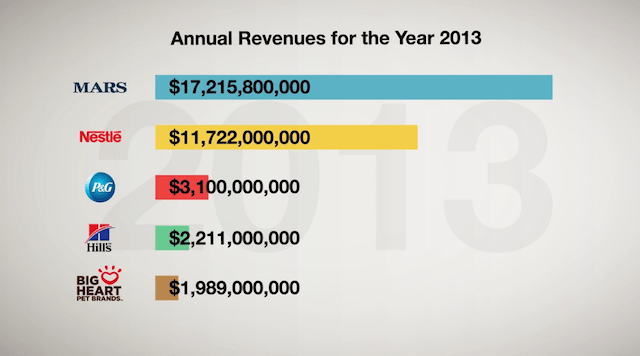
2. A massive and deadly recall in 2007 made consumers lose trust in the industry.
You may remember being part of the widespread panic of pet parents after contaminated wheat gluten killed thousands of cats and dogs. The culprit was melamine, a toxic chemical used in plastic and foam products that causes renal failure when consumed. Although multiple pet products and brands were affected, it was discovered that the tainted ingredient came from a single company located in China. This made consumers seriously question the health and safety of their pet’s food.
3. Our dogs’ DNA is 99.9% identical to wolves, so they require the same nutrition.
Biologically, dogs are nearly identical to wolves, with the small percentage of differing DNA accounting for all the different types of breeds that we know today. Dr. Karen Becker compares dogs’ variety of appearances to humans having different eye, skin, and hair colors, heights, builds, etc. Just because we look different, we’re all humans with the same basic nutritional needs – and the same goes for dogs, whose diets should resemble their wild cousins.

4. Every species requires a certain diet to fulfill their biological needs – and most pet foods miss the mark.
In the documentary, Dr. Becker talks about species-appropriate diets, meaning that each animal has a biological need for certain nutrients. While many wild animals will simply avoid the foods that are unnecessary for their bodies (she uses the example that if you give a snake a salad, it won’t eat it and will just die), our domesticated friends have been forced to consume additives and fillers. Cats and dogs are designed to be carnivores, and while they’re resilient, the nutritional deficiencies of their diets manifest themselves in a myriad of health problems.
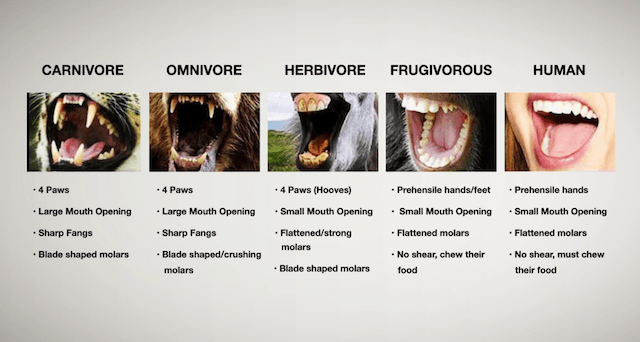
5. When it comes to our pets’ declining health, grains are a huge culprit.
Dr. Barbara Royal points out that the overuse of processed grains like corn and wheat are a cheap way for companies to add “bulk” to their foods, but provide little nutrition for our four-legged friends. The consumption of these low-quality grains, she believes, is the cause for the widespread obesity, diabetes, arthritis, autoimmune disorders, and allergies that afflict our pets.
6. Kibble was an invention of the pet food industry during World War II, and it has led to some serious consequences.
During the war, there were rations on meat and tin. Up until then, packaged pet food was in cans, meaning it had a higher moisture content similar to their species-specific diets (in other words, fresh meat that they killed). But when meat became limited and tin reserved for ammunition, the pet food industry knew they had to formulate a convenient type of pet food that they could package in a bag – dry kibble. Now that this dry food is the norm, pets live in a state of chronic mild dehydration, and rates of kidney disease, organ failure, and diabetes have skyrocketed among pets.
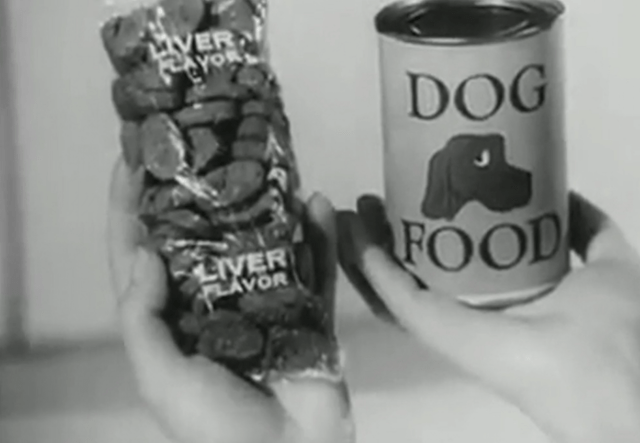
7. The dietary advice from your vet may be influenced by the major pet food companies.
In the film, Dr. Karen Becker points out that the major pet food brands have a large part in funding vet students, therefore influencing their education. She and Dr. Royal point out that there’s a huge lack of education surrounding raw diets, and they’re taught to promote the big-name brands in the industry. What’s more, the doctors say that many modern vets have learned to discourage raw diets because of potential pathogens and bacteria. But in reality, our pets’ systems are designed to digest this material, in part with a high stomach acidity pH of 1. After all, Dr. Becker points out, dogs eat poop and lick their butts on a regular basis – behaviors that could kill a human. While any food brand is susceptible to being recalled (humans make mistakes, after all) raw food companies tend to make smaller batches, and make them with more care.
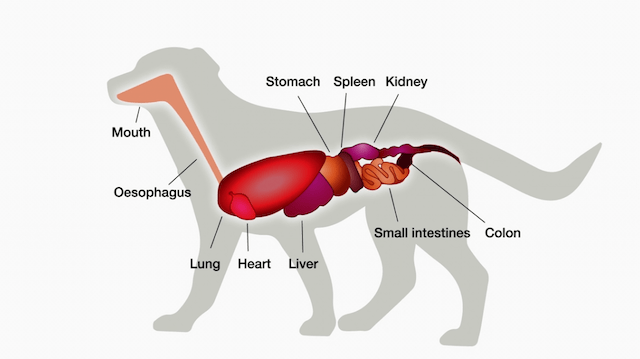
8. The people that set the standards for pet food have more to gain from profits than your pet’s health.
AAFCO – or the Association of American Feed Control Officials – is the organization that sets all the standards for pet food, including nutrient ratios, ingredient allowances, and the terminology that’s allowed on packaging. While this group works with the FDA, it is not government regulated. AAFCO also doesn’t approve products for safety, that’s where the FDA comes in.
AAFCO holds a yearly conference to update pet food standards, and according to Pet Fooled, representatives from major pet food companies attend the meetings so they, too, can weigh in. The danger is that these companies can define terminology and slip through loopholes in order to benefit their profits.
9. The terminology on pet food packaging is NOT what you think.
As mentioned above, AAFCO is responsible for defining terminology on packaging. For instance, your dog’s beef “dinner,” “nuggets,” or “formula” only have to contain 25% meat. If your cat’s food is labeled as “chicken with salmon,” the word “with” may only represent 3% meat. And the label “flavor” is the worst – “flavored” foods don’t have to contain any real meat at all. What’s more, foods with added colors are made to appeal to humans – your pets can’t even see the different hues when the food is dyed.
You also may have looked for protein percentages on your pet’s food. While this is a good place to start, that protein may not be meat. It could have been derived from wheat flour or gluten that’s been fortified with protein.
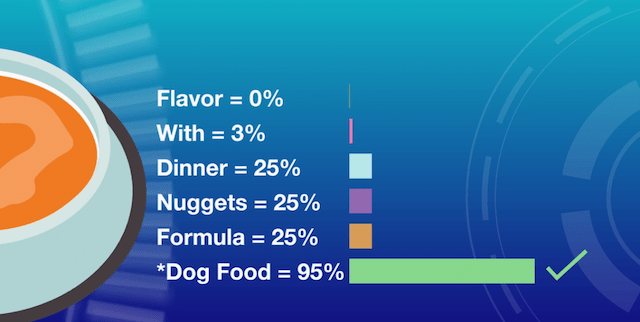
10. By-products are the result of processed animal carcasses from unknown sources.
Meat by-products and meals are commonly found in pet foods. They’re the result of what’s leftover when animal carcasses – feathers, hooves, teeth, and all – are boiled down and processed into a powder. But the most disturbing part is where the corpses could have come from: leftovers from slaughtered farm animals, road kill, diseased animals, and euthanized animals are all examples of what’s being rendered.
According to the National Renderer’s Association, putting the recycled carcasses in pet food is necessary because… well.. where else would they dispose of them?
So, now what?
In the documentary, Doctors Becker and Royal are strong advocates for feeding pets raw diets, food that is very similar to what they’d consume in the wild. If you’re used to feeding your dogs and cats kibble, as most pet parents are, the thought of switching to a raw diet can seem like a huge, expensive, undertaking. But don’t worry, there’s help out there!
If you want to make the switch but you aren’t sure you can commit, even just supplementing your pet’s diet with fresh foods can give them a big boost in heath. (Also, when transitioning your pet to a different diet, you should begin by introducing the new food a little at a time.)
A good place to start is Dr. Karen Becker’s video, The Best and Worst Foods to Feed Your Pet:
For more information about raw food diets for pets, check out these YouTube videos by Dr. Becker. Another great resource is Truthaboutpetfood.com, founded by a pet parent and advocate who made it her mission to uncover the secrets of this industry.
You know your pet better than anyone, and there’s no “one size fits all diet.” It’s up to you, as their guardian, to do your research, be diligent, and decide what works best for your companion and lifestyle.
You can watch the entire Pet Fooled film on Netflix to get all the nitty gritty details that documentary uncovers. You can also rent it on YouTube for $3.99.
Do you want a healthier & happier dog? Join our email list & we’ll donate 1 meal to a shelter dog in need!
Written by Karen Tietjen
Food Recalls and Deception:
A Special Interview with Kohl Harrington
By Dr. Karen Becker
DB: Dr. Karen Becker
KH: Kohl Harrington
DB: Hi, I’m Dr. Karen Becker. Today I am going to interview Kohl Harrington. Kohl is a documentarian,
a film producer, and a film maker. He has put together an amazing project. Kohl you have a lot to share
with us. Welcome, first of all.
KH: Thank you.
DB: Tell me a little bit about the project first. Of course, I have a million questions. What is the project
and what is the inspiration of the project?
KH: The project is Pet Fooled. It’s a feature documentary. The inspiration basically came from my coproducer, Michael Fossat, who had a dog, who had veterinarian problems, itchy skin. The person in
charge or the person hired to basically groom the dog said, “This dog keeps having issues because of the
food. Google ‘grain-free pet food’.” That led to him Google-ing and being confused, which led to basically
a feature film about the topic because it was so confusing.
DB: Kohl, when you were brainstorming about this idea, have you ever investigated anything animal
before? I know that you have been in this industry forever. But were you nervous about approaching, not
much as pets, but pet foods? Pet food as a topic. Were you nervous?
KH: No. I was basically stepping into it clueless. I never heard of anything related to the pet food
industry being a topic alone. I grew up with dogs. I grew up in Florida, so I grew up with dogs. They were
outside dogs. They would roam and hunt things themselves. We had cats growing up too, but the cats,
they would eat the cat food and then go catch their own things. I’ve been exposed to that as a kid. But the
only thing I knew was dogs eat dog food; cats eat cat food. You buy it in can, and that’s basically it. I
stepped into it blind, not knowing anything.
DB: Very blind. You’re learning curve was exponential.
KH: It was about two years into the entire process. Basically the first year was just trying to figure out
what’s the issue. Because whenever you research online, the thing that was interesting to us was that you
had two basic ideas on the Internet about the way the world works: corn is great; corn is bad. Raw is
great; raw is bad. You had basically two worlds that existed. We were just trying to look at both sides to
kind of weave through each side to see which one makes more sense.
DB: Would you say you spent about a year in the research or investigation phase? How long did it take
you to figure out a path?
KH: Basically you’re just online swimming through anything and everything to learn as much as you can.
You’re calling people and trying to dig a little bit more. It took about a year just researching the project
and meeting with people before we had about like, I would say, 15 people who ironically are all in the
Chicago area.
Michael and I both looked at each other and said, “We have a lot of people in Chicago. Let’s just pack up
and go.” We packed up and went to Chicago for a week and spoke with a lot of people. The majority of
the film comes from those interviews that happened in that week.
DB: When you were kind of wading through this amazing amount of information, I’m sure that you
realized that not only is it a very heated topic, a very passionate topic, but certainly in the last 40 years,
there have been all sorts of reasons that people have become very concerned and involved with this topic
with the recalls, and of course, the massive amount of animal deaths because of pet foods.
Were you aware of the recall issue? I know that the allergies, food allergies, or skin irritation in a personal
pet kind of introduced you this topic. Were you aware of the recall issue before you investigated or had no
idea?
KH: Had no idea basically. I don’t think I had ever thought about pet food before. When Michael asked
me, “Hey, I think this can be an interesting topic. It’s confusing.” I was like, “Really?” It just sounds like,
“OK. There’s a problem in everything.”
The interesting thing after it’s made is I feel like a lot more people are aware today about things. They’ve
heard about things. The advent of the Internet. Everybody’s on the Internet all day, every day. These
things like the recall have lived on, because we still have recalls. People are a lot more aware today than I
was. I wasn’t aware of anything. It took me a year to kind of understand what byproduct was. It was
confusing and it’s set up to be confusing.
DB: It is. I know when I met you, you were still in the investigation phase. I love that because both of you
were very objective. You didn’t have an underlying goal other than to learn more and to figure out what
the issues surrounding this industry were, which I think is a noble goal and also a very confusing,
ultimately a confusing goal. You did a great job of kind of sifting through all the issues. At what point in
your research or in the film making process did you have AHA moments? At what point were you like,
“Oh, my gosh. This is starting to make sense in my own brain”?
KH: The reason I kind of thought it was, “Really? Pet food? You want to look into pet food?” was
because there are really well-made documentaries out there and there are really not so well-made
documentaries. It sounded at first a thought of somebody trying to make something out of nothing. That
was my first reaction to the topic.
Whenever we started going through the research and we came across corn is great, corn is bad. The
industry was saying one thing and obviously had people who were criticizing that. My naive thinking at
the time was, “If this is really not true, if corn is really amazing for the dog, these companies will meet
with me and they’ll just fully explain.” That didn’t happen.
DB: Talk about that, Kohl. When you tried to make contact or made contact with some of the industry
leaders, what was you experience?
KH: I basically kept a spreadsheet of everything. Anytime I would contact a pet food manufacturer or a
person who worked at a pet food manufacturer, I would detail it in the spreadsheet. That went from
calling the number, leaving a message, calling the media department, leaving a message, writing emails to
basically personal emails to Facebook accounts that I knew the person worked for a certain company, and
never received a response.
The only response I received eventually was after I had kind of a debacle at a conference. Hill’s Science
Diet called and they left a voice message, which is in the film. “We don’t want to participate in this film.”
Beyond that voicemail, I haven’t received any response ever from anybody expressing any interest in
being in the film. That says a lot. The fact that you’re being criticized for something and you’re not really
standing by it, because you don’t have to.
DB: In your research phase, initially when you were making contact with all of these pet food companies
asking for their input, their perspective, their side of the story and you had no response, you did a great
job of kind of covering all your bases and getting all of the opinions coming in. The people that did
respond to you had passionate strong opinions and ultimately those were the people you interviewed.
How did you go about finding people that ultimately put together pieces of this film in a logical order for
you?
KH: It was a mix of [inaudible 08:29]. The videos that you had you were reading pet food packages.
Instantly, when I saw that, I was like, “I need that scene. I want to recreate that scene. I need that for this
film.” Because it was so brash and just very well-worded and very clear and concise for the viewer to
understand.
The other person that is a major part of the film is Dr. Barbara Royal. We found her in an audio file on a
law website. Basically, there was a guy by the name of Vince Field, who was a law student at the time
and very passionate about pet law. He came to find out there was no money in pet law, so he practiced
another form of law. But he’s still passionate about the subject and that area.
When the 2007 recall had happened, he interviewed Dr. Royal. All he had was an audio file of her. I had
no idea who she was. I just knew that I like the way she spoke about this topic. She was very upfront and
honest. I needed that honesty about the topic. Because there are two types of people that you meet: people
afraid to say anything and people who are brave to say something. These are people who are very few and
far between.
The way we approached everything basically is we would interview people. The interviews actually went
a lot longer than anyone expected. I think our first interview was two or three hours. Somewhere up there.
I would basically take these interviews, transcribe them, and every little detail in the interviews would
lead to somebody else. It was just a constant building of, “This person says one, two, and three. I need to
go fact-check that to see if that really exists, if that’s true.”
[—– 10:00 —–]
A lot of information on the real side of the industry started to make more sense the deeper that I got into
it. The deeper I got into the side of corn, for example… If there was a certain pet food industry leader
saying, “Corn is great because of this study,” I would then go by the study. I would read through the
study. It was very clear that they were picking information and using it to their advantage. The study
didn’t outright prove that anything was better than another thing, but they were basically using a line to
say, “Dogs can process corn,” to then market “Corn is the best thing ever.”
It was sort of those types of things that took a long time to do. It took about two years to fully like, “Oh, I
finally understand everything.” I don’t know if the average consumer is going to take two years to fully
tackle and understand this, but I feel like for anyone to really fully understand it for themselves, it’s going
to take around that amount of time as well. There’s a lot of information.
DB: It’s interesting because just wading through the ingredients that are most commonly put into
commercially available pet food is one thing. But trying to wrap your brain around the raw food industry,
or what raw food is or fresh food in general, that’s probably something that you had never heard of prior
to you taking on this endeavor. You probably had never heard of feeding fresh food or raw food diets to
dogs or cats.
KH: In our initial interview, it’s funny. Because throughout the years, I’ve just been going through the
footage and going through the footage and going through the footage. In our first interview, I remember
laughing at myself in the beginning because it’s like, “What do you mean by raw food?” You literally had
to explain in great detail what raw food was because we had never heard of that ever. We just thought,
“OK, no corn. Great.”
We’ve been conditioned culturally through advertising to believe a certain way. Companies are spending
tens of millions of dollars if not more to advertise their products. After a while, it’s just a normal part of
your thinking. It becomes a normal part of your thinking like, “That’s normal. I need a car. I’m going to go
buy one. I’ve seen this commercial.”
DB: Part of your documentary includes some very touching interviews with people who have been
victims of recalls. In fact their pets have died. How did you contact those people, Kohl? Or once you
realized that recalls existed, how did you track down the people that you wanted to interview that had had
personal experiences with the recall?
KH: There were two recalls that we covered for the film. One was the 2007 recall, which was the largest
consumer product recall ever at the time. Of any product, not just pet food. The second was a chicken
jerky issue.
While we were filming, an issue had come to light where I’d read an article about pet parents banding
together on a Facebook page because they were having issues with sickness or death relating to treats. I
basically got in contact with a person who kind of facilitated the whole Facebook page. She created a
database of everybody that had reported to her that they had an issue – who the person was, where they
lived on a map, was there sickness, if the dog lived or did the sickness result in death.
She had very detailed information with the chicken jerky. Through her, I was introduced to a lot of
different people. If I were flying to Chicago to meet with somebody, I would go around and meet with all
of the different people who would meet with me to say, “Tell me your story.”
Randomly in Birmingham, we were filming at a conference. I took my camera guy to a restaurant he
wanted to go to. Casual conversation. People were like, “Why are you here?” “We’re filming a little
documentary.” “What about?” “Pet food.” “Oh, my God. My roommate just had the worst issue with this
chicken jerky treat.” Even in a bar in Birmingham, people were having issues. We actually got to speak
with her roommate who makes it into the film, [inaudible 14:43].
DB: I’m sure that those interviews – I have seen them – are very impactful. You had interviews that were
insightful, interviews that were very emotional. What interviews where the most difficult or challenging
during this process?
KH: I would just go back to that question, the previous question just to kind of finish my thought. The
interesting thing about the chicken jerky situation was that I was meeting with people and was basically in
real time. In Birmingham, I met with a lady who this just happened to her three days prior. She was still
confused. She had never questioned pet food at all or treats. She would just go and abide what the
package said to her. It’s all-natural. It’s home-style dog. Whatever that means.
What was interesting to me is what was happening was that you had all of these people all across the
country where the same exact thing was happening to them. Sometimes the dog only got sick. Sometimes
the dog died. There are other pet owners out there that fed that treat but never had an issue.
But the interesting thing was that every person involved in the chicken jerky issue did not want to be
involved in the lawsuit. The only thing that they wanted was for the product to be pulled off the shelf, the
problem to be fixed, and to move on. They had something bad happen to them. They don’t want to be
involved in the lawsuit because they’re not going to get anything. They know that. All they want is the
product to be recalled, so it’s not killing more animals.
Each one had problems with calling the manufacturer and being ignored. That’s what that scene points
out, sort of how the company treats the consumer that they care for. That was a very shocking thing to me
to basically call the company myself and have them respond, “Our treats have been tested. The Food and
Drug Administration (FDA) hasn’t found anything.”
I was lucky enough as well to have spoken with the FDA about the issue where they acknowledged,
“There is an issue, but we can’t prove that.” It was this Catch-22 of, “There is a problem, but we can’t find
the smoky gun.” What does that say? You just allowed the product to continue to be sold and continue to
kill until you can find the smoking gun? You know that it’s killing. You’ve admitted that it’s killing. That’s
the way the world works.
The most uncomfortable interview that I had was I would say, we were randomly contacted by the Pet
Food Institute, which is the lobbying organization. They contacted Michael and basically said, “We’re
affiliated with the industry. We want to help you out.” My co-producer was like, “Who is calling?” They
didn’t say who they were for quite a while. It was very odd. They invited us to speak with them. We’re
like, “OK.”
We took a trip to Washington, D.C. where we spoke to both the FDA and the Pet Food Institute. It was
very clear with… Because you just want to sit back and you want to interview. You want to make that
connection and speak from the heart. But with certain questions with the Pet Food Institute… I’ve been
covering this chicken jerky issue, would you please explain what’s going on. It’s their job to represent the
manufacturer. They’re not representing the consumer. The Pet Food Institute is representing the interest of
the manufacturer.
They said on camera and it made me uncomfortable, “There isn’t a problem with chicken jerky. This has
been tested for years and the FDA has found nothing.” Our response was, “We record your answers.” I’ve
spoken with people. I’m not trying to catch you on camera saying anything to make you look bad. I’ve
covered this issue and people are having issues that result in death. Everyone is aware of it. I don’t
understand why you’re basically saying it doesn’t exist. It was very uncomfortable. “The FDA looked into
this. I trust the FDA.”
Whenever you’re speaking with someone, you’re just trying to get their point of view that they care. It’s
hard to draw that conclusion that they care when something is happening. I met with people. These people
are not making this up. There is no conspiracy. You say that you represent the interest of consumers as
well, but I don’t see any evidence that they’ve ever called anybody that I’ve spoken with and made the
interest or the point that they care and they’re trying to fix the problem. It’s just brushed off as “It doesn’t
exist.” Now, that’s uncomfortable.
DB: Very uncomfortable. I’m actually really surprised that PFI even talked to you. I think it’s interesting.
But I’m not surprised by their kind of evasive responses at all. I’m not surprised at all.
KH: It’s different to have the dichotomy between speaking to you and Dr. Royal and a lot of other people.
Even the FDA was open and honest. They were like, “You can interview us for 30 minutes. Be quick.” It
turned into a couple of hours, because the topic is so in-depth and interesting. At the end of the day, what
I gathered from the FDA interview was “Sorry, there are laws. We follow the law.”
[—– 20:00 —–]
If they were speaking in code with their eyes, that is what I took from the interview. “We know there’s a
problem, but we can’t prove it.” It’s frustrating. They were using terminology to me that said that they
cared. They wanted to help more. But what can they do if it’s not in the law that they abide by?
DB: I know that you have flown around the United States. I know that you have gathered countless hours
of footage. How did you pick and choose? How long is the film?
KH: The final film is 71 minutes. We’ve shot hundreds and hundreds of hours of footage of interviews.
We didn’t know anything. We were shooting and learning at the same time. Interviewing someone for a
couple of hours was very valuable to us, because we were able to have transcripts after interviewing
someone with a lot of information. Especially from interviewing yourself, where we could then use what
you said and find the facts behind everything that you said, which would then help us in the end.
The difficult thing about making a film is that you’re translating this basically what could be a
conversation into a visual aspect. For me, it’s like translating English into a different language. It’s where
you can have a conversation in person with someone, but watching a film is an experience in and of itself.
I had to weigh a lot between this making the most sense for the consumer watching and not getting bored.
It’s like stitching a quilt really. What topic do we talk about first in order to get into this topic in order to
get into this topic? Because if the order became mixed up, the viewer would lose all interest in the topic
and be confused.
DB: I’m impressed that you were able to condense the volume of information down under 80 minutes. I’m
totally impressed. What do you think the biggest takeaway for you personally was? Because your learning
curve has just been like vertical on this entire topic. What do you think you’ve learned the very most from
finishing this entire project?
KH: The reason why I liked the film is that it’s Pet Fooled. It’s about pet food but at the same time it’s
not about pet food. There are many different undertones of this film that represent other industries. The
thing that kept me going throughout the years was the fact that I believe, as an American citizen, you have
a right to question companies. You have a right to question your government. It’s very clear that the
industry does have influence towards people questioning this product, questioning this industry, really,
and the products that they sell.
That’s what kept me going throughout the years, the fact that I believe that you have a right to question
what you’re being sold. You have a right to transparency and know what is in what you’re being sold.
That was what was the biggest shock to me was that it really took a lot of time to just understand the
basics of what’s in these products. What should you have? What shouldn’t you have? What should you
avoid? That was the biggest shock was that how misleading – I don’t know the corrective terminology to
allude to how shocking the way this industry works.
DB: Deceptive. Deceptive is the word that I use.
KH: Deceptive. Yeah.
DB: Yeah. It is. This is a five-year project, Kohl? Is that right? About five years?
KH: We thought it would be two years. Then it turned into five. That’s the way it always goes if you
make a film, a documentary.
DB: Privately funded? I know nothing about the film industry. How do the logistics of funding and the
distribution work?
KH: It was extremely low-budget. Basically, we had the funding for what we filmed. Filmed everything
and hired the camera guy and hired a couple of editors to help us out along the way. Just friends and
family. That was what allowed us to get through. Once we moved into the distribution phase, we said
“Here’s our rough cut product. We can’t afford to finish it.” And so whoever wanted to distribute it and to
like give us finishing funds to finish the movie. It’s a shoestring budget.
DB: Some of the best documentaries I have ever seen have been made exactly this way. I’m so excited to
see the finished version if people – I know everyone watching this is going to want to see this, Kohl.
Where are they going to go to see it? How are they going to get a hold of it?
KH: Basically, Gravitas is a company here in Los Angeles. They’re our distributor. They deal with video
on demand (VoD). It’s basically going to be on all digital platforms. If you have a certain cable provider,
let’s say, Time Warner is big here in Los Angeles, you can tie on to your VoD, through your Time
Warner and find Pet Fooled. You can find it on iTunes, Hulu, Vimeo on demand. Basically, any digital
platform, Xbox, you can find Pet Fooled. We wanted to make it as widely available worldwide on any
digital platform that we could, because that’s where consumers are going to be able to watch this film.
DB: Yeah. Absolutely. What’s your projected release date?
KH: The release date is October 4.
DB: So exciting. Very exciting. I was honored and flattered to be a part of this documentary. I’m excited
about what it’s going to accomplish in the sense that – you’re absolutely right. In five years, there has
been evolution in the industry. But the majority of people still have no idea that there are issues within the
pet food industry that they at least need to be aware of to make the very best choices for the animals that
they’re caring for, certainly.
I appreciate your conviction in hanging in there to finish this. It’s such an important topic. You’re really
one of the few people I know that have had just the ability to want to tackle it and get the job done. I
appreciate everything that you and your team have done. I can’t wait to see the finished product. Thanks,
Kohl.
KH: Thank you, too. Thank you.
[END]

source https://animalfoundation.com/whats-going-on/blog/importance-walking-your-dog
Walking your dog is about so much more than just “potty breaks.” Walking your dog provides mental stimulation, physical exercise, chances for socialization, and opportunities for behavioral training. Moreover, it gets both of you out and about while helping to grow the bond you have with your dog.
Walking Provides Exercise and Mental Stimulation
Walking your dog regularly provides a basic foundation for physical and mental health. Like a child, your dog wants to know the world. If he or she is confined to the house for too long, your dog will get bored, and boredom can lead to destructive behavior. Your dog is dependent on you to take them out to explore the sights, smells, and sounds of the world. This is why it’s also good to vary the places you take your pet as dog much as possible. You’ve probably noticed how busy (and excited) your dog gets when he or she is walking, so let them enjoy every opportunity to discover!
Walking is Good for Your Dog’s Health
Remember, too, that a sedentary pooch can quickly become an overweight one, and that brings potential health problems with it. Even if your dog is active inside the home, he or she still needs another outlet for pent-up energy. You’ll benefit from having a well-exercised dog, as tired dogs tend to behave better, and you’ll help your pet avoid unnecessary weight gain!
Walking Helps with Your Dog’s Socialization
While out walking, your pooch is most likely going to meet other dogs. This is a great opportunity to help your dog learn acceptable ways of socially interacting with new animals. It will also help build doggy confidence so your pet will be less afraid to make friends. If your dog does show fear, taking them to a training class is a great way of removing that anxiety in a more controlled environment. Well-socialized pups still like a bit of rough-and-tumble play with other dogs when out for a walk, but they’ll know when to stop and will come away without any battle scars. Walking your dog and exposing him or her to different dogs, people, and situations is a win for everyone.
Walking Your Dog is a Training Opportunity
When walking your dog, consider it a training opportunity. Dogs aren’t born knowing how to walk on a leash, so you’ll have to teach your dog how to follow your lead. On these walks, you can begin teaching commands like, “sit,” “stay,” and “heel,” especially if you take treats along to use during the process.
Just Walking Your Dog May Not be Enough
Exercise needs are based on your dog’s age, breed, size, and overall health, but a good rule of thumb is you should spend at least 30 minutes every day on an activity with your dog. Younger dogs and dogs bred for sports or herding activities may need much more.
If your dog has a yard to play in, walking isn’t the only form of exercise available. However, don’t expect your dog to create their own exercise routine just because you’ve put them outside. Dogs don’t self-entertain, so if you want to tire your pet out, play catch or fetch! Find more ideas on what activities you and your dog can do together in The Animal Foundation’s Guide to Your Dog’s Play Time and Activities.
If you’re at work all day, consider taking your dog to doggie daycare, hiring a dog walker or asking a friend to take your dog out during those hours. Your pet will enjoy the company, and you’ll come home to a happier dog waiting to greet you.
Ready to get out of the house with your four-legged friend? With this insight, you’ll never look at a walk with your dog the same way again! Don’t have a dog of your own to walk? Volunteer with The Animal Foundation and help enrich the lives of our pawsome shelter pooches.
source: GMOs revealed
One suspect is the widespread use of Roundup. Studies show that glyphosate (the active ingredient in Roundup) is found in the bodies of 93% of all humans tested. It’s everywhere…in our food, in the air, in the water.
The amount of glyphosate found in a dog’s body is a full 5,000 percent more than that found in humans. Why are dogs exposed to so much more than humans?
Even if you don’t apply Roundup to your yard, the chances are good that your dog is exposed to it every time you take him for a walk. Public parks, schools, and fields are often treated liberally with herbicides, and dogs pick it up on their paws as they run through it.
The chemicals from the grass leach into your pet’s body, and are licked off as the dog cleans itself. Not only that, but many brands of dog food contain soy, corn, wheat, and other ingredients that have been grown with Roundup.
The Lance family employed a yard-care company that applied Roundup to their grass once a month. The yard was weed-free and looked terrific, but they have been left not only with the pain of losing their canine companions but also with the painful question… did glyphosate kill their dogs?
They have discontinued the use of Roundup on their property and, when they are ready for a new dog, they plan to do things differently. But it won’t bring back what they’ve lost, and they are understandably upset that they didn’t know the risks that glyphosate posed to their pets.
How can you protect your dog?
First of all, avoid treating your own grass with chemicals. Keeping your yard safe by using natural and organic weed and pest control not only protects your animals but your family as well!
Second, consider protecting your dog’s paws with breathable, anti-slip dog shoes when you’re walking in areas that use chemicals. Remove the shoes immediately when you get home to prevent your dog from licking them. Or, wash her paws carefully when you come home from a walk.
Finally, buy grain-free, organic dog food. It may cost more, but between a dog’s increased exposure to glyphosate in public places and the poor quality of many brands of dog food, it’s worth it to protect your fur baby’s health.
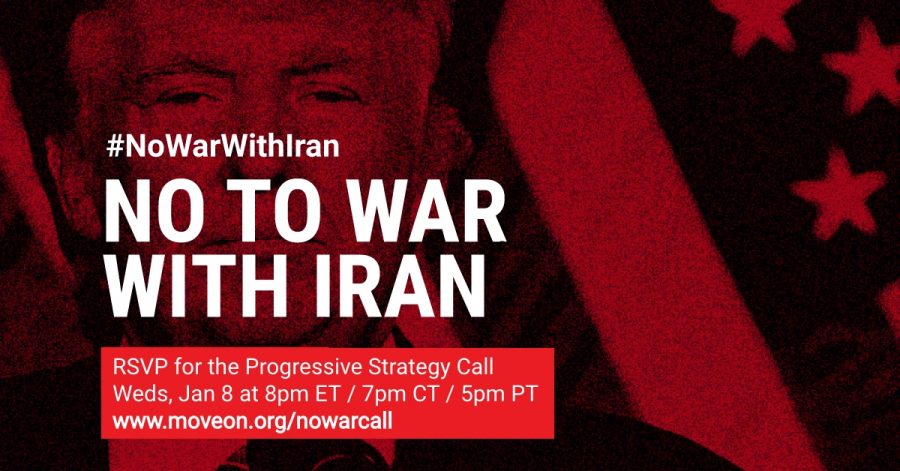
Trump issued an assassination order for Iran’s top general, escalating tensions and bringing us dangerously close to another endless war. And tensions continue to rise as over the last 24 hours Trump has used Twitter to issue dangerous and reckless threats to the Irarian people. Congress must use its power to stop Donald Trump’s reckless march to war with Iran.

Here is what we know so far about the situation, which is still unfolding:
- Donald Trump brought us to the brink recklessly and unnecessarily. After successful diplomacy by the Obama administration and an intensive campaign from grassroots leaders, including MoveOn, to approve the Iran nuclear deal, the risk of war with Iran was at its lowest point in decades. Since taking office, Trump has surrounded himself with war-hawk advisers and changed course from pursuing peace to acts of war. His attacks, from the Muslim Ban to withdrawing from the Iran nuclear deal to painful sanctions on Iranian citizens to the military assassination this week, make America less safe and could incite a war with devastating consequences for Iran, Iraq, the United States, and other countries across the globe.
- War with Iran would be catastrophic, potentially worse than the wars in Iraq and Afghanistan combined. Starting a war with Iran would likely destabilize an entire region, funnel U.S. resources into an unwinnable conflict, and unleash mass-scale human suffering on Iran’s 80+ million civilian population and beyond.
- Only Congress can decide whether U.S. forces should be put into harm’s way. Congress has the power to authorize war, and a bipartisan majority in both the House and Senate recently voted to prevent Trump from starting another war. However, that language did not make it into the final bill.
So here’s our chance: We need Congress to declare Trump has no authorization to use military force in Iran and cut off any money he might try to use for more attacks.
How can we do it? RSVP now for a mass call on Wednesday, January 8, at 8 p.m. ET/5 p.m. PT to come together to stop Trump’s escalation to war with Iran.
Endless wars feed billions of dollars into military contractors and their wealthy owners and cost untold numbers of lives from all countries involved. MoveOn members have been leaders in the anti-war movement since our founding and played a crucial role in the opposition to the Iraq War. We must continue to work for peace as an essential part of how we create an America where everyone can thrive.
As we welcomed in a new year and new decade, none of us anticipated or wanted this incident to define how this new decade begins. Trump’s recklessness knows no bounds. Whether you are feeling hopeful or weary, ready to take to the streets or seeking reprieve from relentless organizing, or a valid combination of all of these, this call is for you. It is an opportunity to come together as a nation and as a community. We are in this together.

In the video, the poor mom, a baboon, – can be seen staring at the battered and bloody corpse of her baby where he lies in the road.
The monkey then runs her hands through the youngster’s tail, picking off parasites as if her baby might still be alive.
Seeming confused, she then pulls the baby monkey close to her chest, but its lifeless body does not cling to her to be carried as it had so many times before.
Speeding driver blamed after three impalas found dead in Kruger Park
27 December 2019 – 13:36
The Kruger National Park has expressed its shock following the discovery of three dead impalas.
The buck “seemed to be knocked down by a speeding vehicle,” said park authorities on Friday.
“We call upon anyone who might have seen this incident to please come forward with information.”
The speed limit in the Kruger is 50 km/h on tar roads and 40 km/h on gravel roads. Visitors to the park are routinely asked to be on the lookout while driving and to always give animals the right of way. Cage set up to help capture leopard at Kruger National Park camping site SanParks says there has been no sign of the young leopard which entered a camping site at the Kruger National Park on Wednesday eveningNEWS1 week ago
“We continue to urge visitors to observe the rules of the park and keep to the speed limit at all times. One animal killed is one too many,” said park officials.
A month ago, a tourist was killed and three others injured when a giraffe was hit by a vehicle carrying 13 passengers. It then fell onto a rented safari vehicle driven by the Swiss tourist, crushing the roof. The giraffe died on impact. The tourist was critically injured and later died in the hospital.
Police spokesperson Brig Motlafela Mojapelo said at the time that authorities had changed a case of reckless and negligent driving against the driver of the minibus that hit the giraffe to one of culpable homicide after the death of the tourist, identified by police as Roland Koller.
In May, a bakkie and a car literally gate-crashed their way into the Kruger Park within the space of just two hours. The first crash at the Paul Kruger Gate happened at 9pm. The second happened at 11pm.


